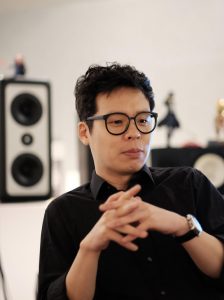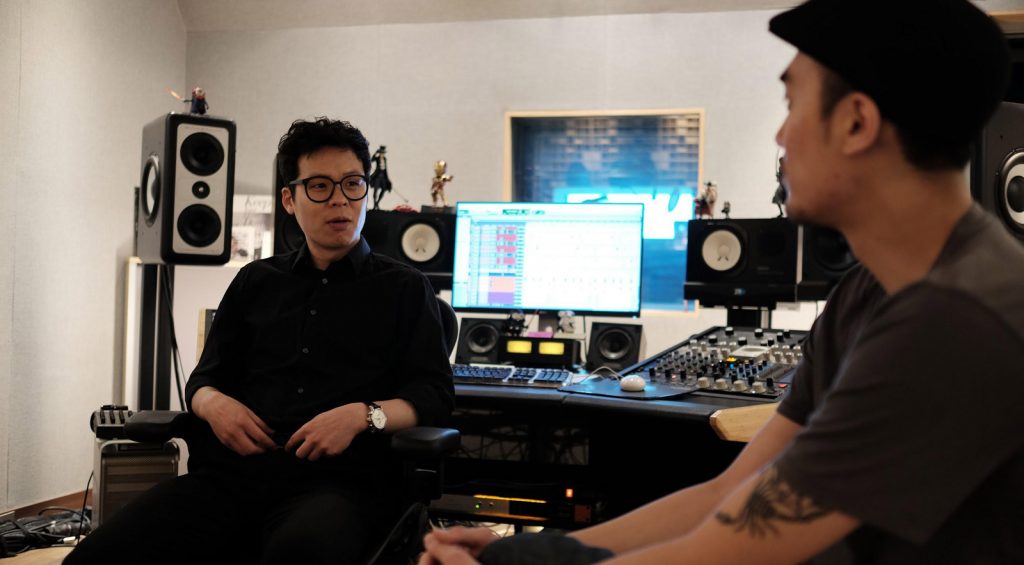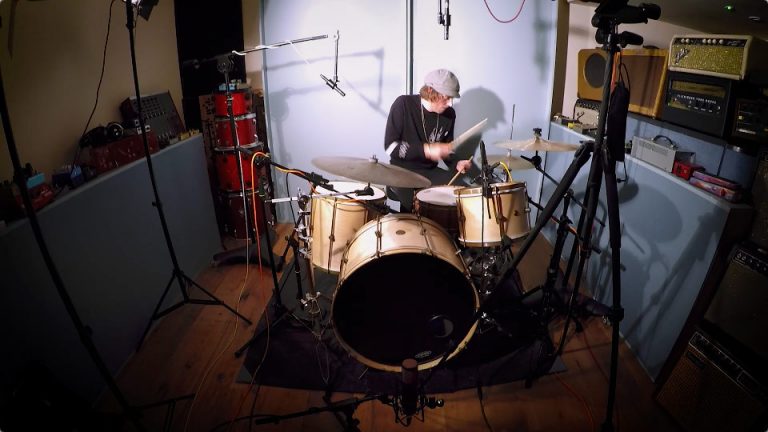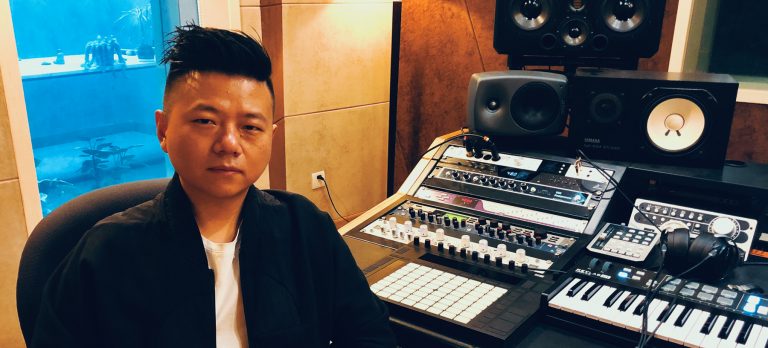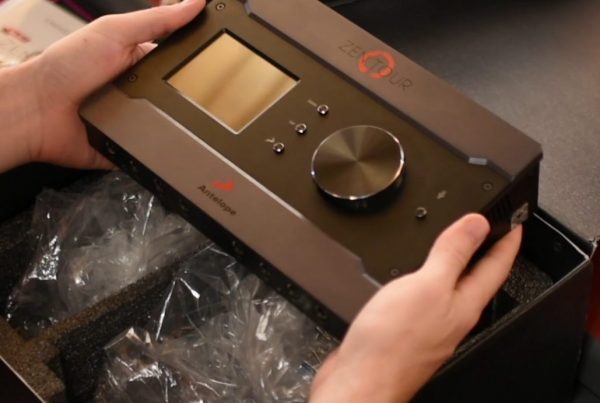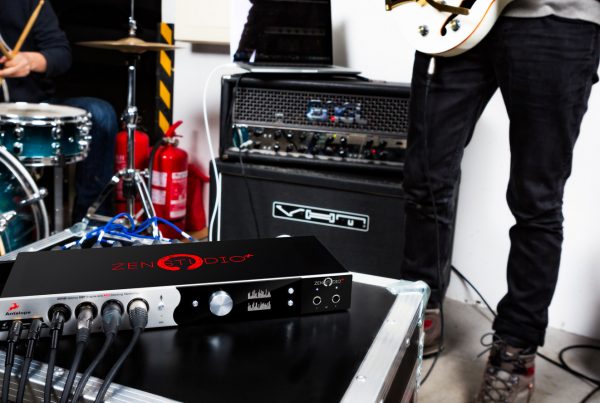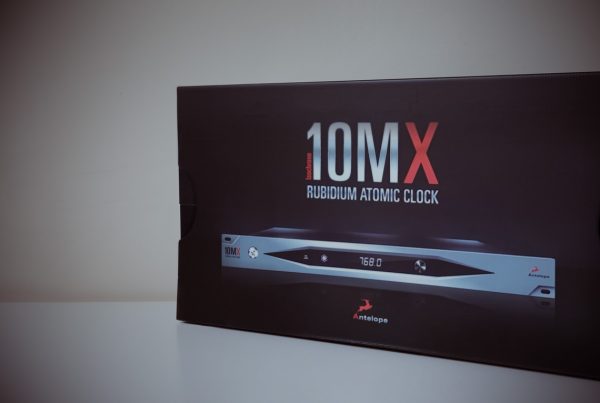Recently, K-POP has become one of the main streams of world’s music scene. Being different from other countries’ idols, K-POP musicians are armed with the highest quality in view of music itself, and performance. There are many big names in the K-POP scene, but the most impressive works are mostly coming from K-POP pioneer SM Entertainment.SM Entertainment has produced well-known K-POP artists such as BoA, TVXQ, Super Junior, Girls Generation, EXO, SHINee, f(x), Red Velvet, NCT, etc. They are not only famous for these artists, but for the fact they are always working with the world’s top class songwriters and engineers.
Mr. Jong-pil Gu is the recording/mixing engineer in SM Entertainment recorded and mixed Only One – BoA, View – SHINee, Hoot – Girls Generation, Monster – EXO, and these are only a few references from his works. In this interview we talked about how SM Entertainment produces a song and what kind of gears he is using.
Could you introduce yourself?
Hi, my name is Jong-Pil Gu. I’m a recording and mixing engineer in SM Entertainment. I started my career in 2001. Now it’s been already 16 years.
You must have done so many projects in 16 years.
Actually, I don’t remember everything that I did.
Compared to 16 years ago is there a lot of difference in your workflow? Please tell us about the change from the analog to the digital era.
It has changed a lot. When I first started working it was reel tape era, more specifically, the time when reel tape and Pro Tools coexisted. Back then, people were reluctant to work in the box because of reliability, so tape recording was preferred. The whole workflow was very different.
How did it change in detail?
Basically, I think it was the musicians who led the change to digital not the engineers. It’s cheap, easy, and they could make their own environment as they liked so they can finish their demos in the box. Before then musicians had to bring all their gear to the studio and record all MIDI tracks, but they started bringing their projects on CDs or USB.
However, the shift to digital didn’t happen in the blink of eyes, so we converted the files into reel tape and mixed. And then a big change came. No store was carrying reel tapes anymore. Meanwhile HDD became cheaper, and reliability was enhanced, so there was no reason to use expensive reel tape anymore and the change was accelerated. Famous composers started trying to finish their works by themselves in order to preserve their creativity.
Tape recording needs a lot of preparation in the studio, right?
At least one hour. Back in the day people thought the studio with tape machine is a good studio.
Is tape machine a super-expensive gear?
Studer machine was like $100,000. So if a studio had this, people believed it must be a good and big studio. Lots of booking. So preparation took so long.
So, this is an in-house studio that only SM artists can use?
Yes, correct.
You said you used tape and hard disk. And there are tons of tape emulation plug-ins nowadays. Comparing those to the real machines, there should be physical differences rather than just a nostalgia, do you actually feel the difference?
I didn’t know well back then. I don’t think I understood the workflow very well, so I actually couldn’t feel. But a few years ago I had the chance to feel the sound of the real machine. I still have the master that I worked on for the first time. I listened to it, regardless of my mixing skill, the sound was so different.
You mean different in a good way?
Yes. These days the sound is dry. Even when I put in the emulations I feel the difference. I don’t think it’s just from the media but it’s coming from all accumulated differences when we make the tracks such as VSTi. By the way, I was surprised when I listened to it. Other engineers who worked in the reel tape era say the same thing. ‘Something isn’t like it was before.’ That ‘something’ is a very emotional one so it’s hard to say what exactly does this mean.
So, people don’t use tape machine these days?
In SM Entertainment not anymore.
Not even for effects?
I did once before joining SM. It’s good if you understand the machine well. I was vaguely thinking it would sound great if I use it. I didn’t know that I have to pick the right tracks to get the tape effect and not all of them because all the harmonics from each track are accumulated. So I sent through all tracks to the tape machine, which was tons of work. Thinking about it now it wasn’t even that good. BUT, it looks cool though (laughs).
I can’t even see a console in this studio. What is your current workflow?
Pro Tools for everything.
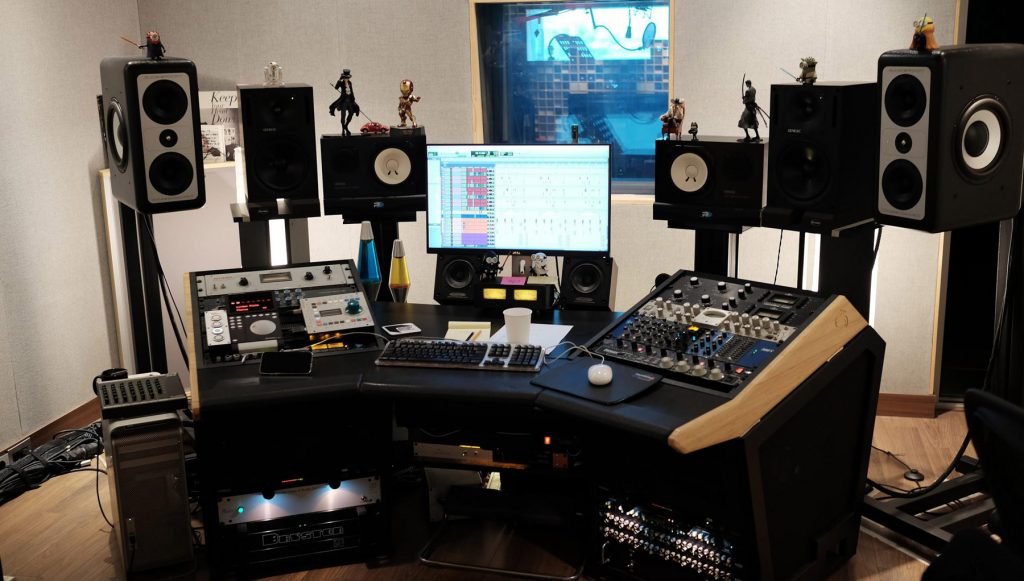
He uses only Pro Tools, without console, and all processing is done in this studio.
Not only Korea, but the rest of the world also are very interested in SM Entertainment’s production. Could you tell us the full procedure for making records?
We collect demo songs and our A&R team filters them. We find a song that fits our artists, request the lyrics and record the vocals.
Are those procedures handled in this studio?
The A&R office has their own monitoring systems so they work at their office. There is one more producing system in SM: Songwriting camp. During a specific period, Korean or foreign composers are gathered together and write songs. We pick the good songs from the camp and proceed to a project. In this case, the song is born and raised in the studio.
Do you only record vocals?
Yes. Lead, backing, chorus, etc.
Recording and also mixing?
Yes. But mainly mixing.
Do you sometimes record in other studios and just mix it here?
We have a so-called principle: Starting inside, finishing it inside, and starting outside, finishing it outside. It is much easier to manage the data if we stick to using only one studio. Even in SM studios, we tend to stick to the same room. It is quite old-school and somewhat inconvenient, but it gives us better results.
What project are you currently working on?
I’m working on the new project of NCT 127 to be released soon. Also many other projects are going on, but I cannot tell you the details.
How many songs will it be on this album?
Seven songs and I’m working on two of them.
Your schedule seems to be very tight, so efficiency must be very important. As far as I know, engineers have their own know-how and habits. Do you have yours?
I actually don’t. I start everything from scratch, so it takes quite long. I think I rarely use the same set I used before. I like it that way.
Then, how long does it usually take to finalize the mix?
It depends. Sometimes one day, sometimes a few hours. In some cases, I stick to the same track for three days.
Each song has different tracks and characters?
Some genres I can easily catch how to mix, and some others I find more challenging, then I’ll certainly need more time.
Which genre are you most confident with?
I’m not confident with any specific type of songs, but working at SM Entertainment I feel I’m getting better at making music that sounds better and makes people dance. On the other hand ballads don’t contain many tracks, sometimes it takes a few days. Basically, SM projects have a lot of vocal tracks, so it takes quite long.
Among the projects that you did recently, which one took the longest?
This NCT 127 project that I’m doing now takes long. There are many situations that make me difficult. One of them is that Mr. Soo-Man Lee is not only the owner of the company but also the producer who monitors the process in detail, especially for the title tracks. So we have to express the tracks following his directing. In this point of view, this project needs some extra time.
Mr. Soo-Man Lee’s guide is quite in detail?
Very specific.
Something like, boost 1 dB here?
Not that way, it is more like this: if the track uses 808 sound, then he says ‘this 808 sound needs a push at 50 Hz. Even cutting low end, I want it more punchy in that range.’
He has a lot of knowledge!
Yes! That makes me tired! (laugh)
Let’s get back to the new project, what kind of song is it?
Basically, it is hip hop based. We tried hard to add many things like: characters that idol should contain, performances, visual elements, things that fans want to see, overwhelming music.
Even if you usually work on dance tracks, they are all different like hip hop based, house based, etc. Do you have any difficulties to work with all these different styles?
Many difficulties. First of all, I need to master all different styles of music. Besides, I grew up in Korea, so it is not easy to be competitive with western people because many projects in SM are coming from foreign composers.
Do you follow any different methods when working with foreign musicians?
Not really. People think foreigners work together gathered in a studio, drinking, smoking, chatting… in a very free atmosphere. But professionals don’t. If they need to finish this project today, they gather, focus, finish it. Just like Korean musicians.
I think recording process is quite different between Korea and the foreign countries. For instance, in foreign studios, they use compressors and EQs a lot during recording, or when tracking a guitar with multi-miking, they print the track and decide the tone. Koreans don’t do this, right?
As I normally record vocal only here, I would have to tell you about vocal recording. If I manage the project from recording to mixing, I like to compress and EQ quite strong. Each member of the group has a different timbre so I always face a dilemma. Should I make a tone that suits to the track or should I preserve his/her natural tone? For example, this guy has a nice low tone, but not much suitable to this song. In this case, I have to cut the low off, then the voice loses his character.
By the way, I tend to use aggressive processing when recording. Now I like LA-2A a lot. When I bought that from Gearlounge and used it for the first time I was shocked. I was surprised how recording can get this easy! Of course, there are disadvantages, but the truth is that recording vocals got very easy.
What made it so easy?
Leveling control is very convenient. Idols have all different vocal skills. Some can make a good tone easily, and some can’t. It might be that they are not familiar with recording. In this case, it is very helpful to have the skills to make a good tone.
So, making the singer comfortable affects the vocal performance?
Yes. Using the LA-2A makes the sound better and the singers can’t feel their voice is actually being compressed. As an engineer, I can put the limit that I want to push the sound to. It might be different in other studios. Because we don’t have to give this source to the client. So I think I feel more comfortable and free to go. So I use EQ’s more aggressively.
So, you can be more creative than other studios?
Yes and us, the engineers, take authority too.
You can freely express your creativity and character as an engineer?
Have in mind using this aggressive method can sometimes make the recording go bad. Luckily both the artists and me are in the same company so it is much easier to explain that to them and ask for a re-recording. They surely understand that quality is the priority.
You have worked with many artists in SM, who is the most impressive?
BoA, of course.
Why is that?
First of all, I like that she has the attitude to express her opinion. Also she fully trusts the people she’s working with if they have proven themselves as professionals in their own ways. Most of all, she is a really good singer who can convey the emotions of the songs, so she is a very good artist to be happily working with. Actually, she is so famous and also an important artist in SM entertainment, so I feel both pressure and burden to do my best. But she also has the power to make the working atmosphere softer and take that stress away. She makes people comfortable to do their best as she gives full trust. Lastly, the work that I did with her sticks to my memory, because of her important position – the best in SM, the best in Korea.
BoA worked in Japan a lot. What kind of difference in sound do you feel between those days and now?
In short, J-pop sound and American pop sound. J-pop’s sound is more adapted and twisted from American pop.
K-pop tends to pursue the sound of American pop, right?
Yes, it is. BoA has very sensitive ears. Once, she heard the final mix and said that the reverb is too long. So I shortened only the reverb time, not even the amount. After I send the new mix, she said that the reverb felt better now. I was confused. She could hear what I even can’t hear!
Also, she sets up the exact goal, so it is easier to work with her since she knows where we’re headed to. And most of all, she always prepares for the recording sessions and practices a lot. That is so professional and cool. I almost never saw her needing to listen to the guide. She is perfectly prepared and just goes for it. Checking the syllable and timing is already done before she walks into the studio. She is like ‘the lyrics in this part doesn’t fit together well. Shouldn’t we change it a bit?’
Then, there is no vocal director when she is recording?
She prefers to have one. Whoever it is, she wants someone to guide.
To get more objectivity?
Yes. Also, monitoring in the booth and out of the booth sound different. Sometimes she does everything on her own. Records in the booth, listens to it and then slightly changes the line, everything. But most of the time, she prefers to work with a vocal director.
Let’s talk about the gears. You said you don’t have any signature signal chain, but you might have preferred gears.
When I’m recording, I love using the Neve 1073. I realized why people love it right after I used it for the first time.
More specifically, what did you like about it?
You will know when you mix. It is very difficult to record and compare the same source from 3 different preamps. So it is not easy to judge if it is good or bad, but you can figure out when you mix them. It doesn’t lose any juicy mid tone while the mix is finished. Also, it sounds like it doesn’t have much mid-range, but if you boost a bit, you will notice it. Low-range is firm and tight. So if you find the right spot to cut, you can preserve the whole low range of the vocal. I think the combination of 1073 and LA-2A is a killer. It goes well with most of the vocals.
Was there any exception?
Yes. I don’t remember which preamp I was using, but I changed it at some point to another one and the sound got much better. I tend to get used to gear I’ve liked once, but whenever I run into this kind of situation, I learn that I need some flexibility.
After making a good sound with preamps and amps, I think it is also very important to properly convert analog to digital. Do you have many experiences of A/D converters?
I’m using AVID HD I/O and I have used a lot of A/D converters. Actually, I couldn’t feel big difference switching only A/D converters. It might change a lot if A/D, D/A, with many many channels are accumulated, but only with A/D converter, there are too many factors remaining. So if time goes by, even I cannot distinguish which one is which. So I felt it is not very meaningful to me.
People say the clock is important too when you have many digital units. Why is that?
I explain clocking to people like this:
All different digital formats have individual ID. Signals in different formats run on the one road with an individual rule, so it hitches and crashes. Word clock is the king who can control the road giving one united law, so all the signals can go to the goal point faster and even safer. If you use different formats together, there will be crashes and jitter. Sometimes it’s hearable, and sometimes it’s not.
Even if engineers can’t hear them, does jitter actually affect the final product?
I’m pretty sure it does. What I can tell is, many things are going underneath in the digital world, and word clock manages them better. For example, it takes forever when you turn on a Windows PC. We can’t see what is going on in the box, but inarguably there is data in interaction. What I want to say is, something is simultaneously and continuously working in the box, its components are interacting with each other. And it needs a supervisor. Without a supervisor, some workers will stop working.
Is it like a good communication between producer, engineer, and artist?
Yes, it can be put this way as well. Also, imagine it like this: there are two bird-view photos of a parking lot. Cars are parked in a row neatly in one picture and parked in a messy way in the other one. People will like the first picture. If something gives a direction, there will be a lower chance to crash. It can be jitter, or something else. The scientists will say. (laugh) Not only in this theoretical reason, but also I actually felt it. Especially when having more and more digital pieces of gear you’ll notice that more problems occur.
You talked about the clock in view of synchronization, then what is the reason to use an expensive clock with high precision?
First of all, the price and the quality is proportional. I have used many clocks until now, and this Antelope clock was the only one that didn’t allow any errors. I was having jitter issues when using other ones. The sound would suddenly disappear and come back again. Then the LCD would blink and the connection was lost. So I had to disconnect and reconnect again and again. I don’t think it happened because of electrical problems. Hardware-wise the quality of the clock is what makes a difference. I have never dealt with this kind of problem since I’ve started using an Antelope Audio clock. If you ask about the sound, you should experience it in person. The sound is subjective, but reliability is definitely objective.
Like a good audio interface, you can forget about it after connection. Is it similar to it?
Exactly. There are many reasons why people love expensive cars but the main reason is probably that you don’t have to think about small problems. I used Isochrone OCX for 7 years before getting OCX HD.
What is the difference between Isochrone OCX and OCX HD?
OCX HD became more convenient because of its software. But using software is a hurdle. I couldn’t use it on Mountain Lion OS. Also, I feel unstable for software controlling device. On the other hand, what I like about Antelope’s clock is that I could save the clock rate in banks. The projects have all different sample rates from 44.1 to 96kHz and I need to switch quickly. So this function helps me a lot.
Then, what can we expect from high-end master clock like OCX HD, in view of sound?
It gives you clarity. We can’t measure it in numbers, but you will definitely feel it. There is Pan Depth setting in Pro Tools, which controls pan width from -2.5 to -6. I usually set it up at a certain figure, but I can feel the difference if there is an external master clock. The width is different and the each piece of sound sprayed in a stereo field has more clarity. So if you have to widen the stereo image, you can get natural wideness yet with a firm center image and bass. It really gives you clean and clear sound.
Once, during a live concert, we were preparing with the ordinary setup. Digital console had a problem and I could hear jitter. To deal with this problem I suggested to use an external clock and the sound became totally different. The staff from the concert hall were even more excited. I think the sound difference at a live show is much noticeable. You might know this, but SM has a lot of concerts abroad, but it’s still quite difficult to rent Antelope Audio gear. That’s sad. Because of this I thought it would be great if we could use master clocks at every concert, connecting the digital console, interfaces, and everything.
I saw a picture for a FOH at Jay-Z or Beyonce’s concert that everything was connected with 10M clock. That’s how I came up with the idea to use the clock at our concerts. And boom! Nailed it.
What do you think the strength of OCX HD, and who do you recommend to?
A multi-output is one good thing. So people with lots of digital gear need to have one. Not only 8 Word clock outputs, but each of them can also send a different clock rate. This OCX HD can handle 2 multiple rates, such as x1/2, x2, x4, etc. So I can send 48kHz and 96kHz simultaneously.
What is the weakness?
Antelope’s Trinity master clock has this option, which I wish the OCX HD als had. I’m talking about the ‘Multi-clock’ option. I hope I could use 44.1 kHz and 48 kHz together. We print the master at 96 kHz, but if the project is 44.1 kHz I can’t synchronize both. If I double 44.1 kHz, it becomes 88.2 kHz. Not 96kHz.
Besides this, I recommend OCX HD to all the people who have many digital units. It is essential. You might think it is expensive, but it will solve one big problem for you and will bring comfort instead.
As far as I know, the standard of K-Pop is 24-bit/48 kHz.
Yes. I wouldn’t say it is the ‘standard’ but this is what is normally used. In my opinion, 48kHz is widely used because with bigger sample rate it can be closer to the analog signal. And as for the 24-bit depth, it allows a wider dynamic range. Back to the tape era, the tape was 48 kHz. When Pro Tools was introduced, people needed to synchronize Pro Tools with the tapes. I think that’s why people started using 48 kHz. Actually, there was no reason to keep the sample rate because all the digital data was copied to tapes and controlled on the console. So no clock was needed. After finishing mix on the console, mix-downed the master to 16-bit/44.1 kHz. I think this is the origin of the 48 kHz sample rate and people are still using it.
You said bigger sample rate results in sound closer to the analog one. Then why don’t we use 96 kHz?
First of all, too much data. The computer gets slower. And even software gets slower with the track count growing. Most of the plug-ins don’t support 96 kHz. But it sounds great when you record at 96kHz for a small number of tracks like 8 channel classical music recording. Once I attended a recording session of classical music at 96 kHz, and the violin sound was totally different from what I’ve heard from other recordings from the same hall. The hall was B3 floor, but I felt like I could hear the cars passing by on the ground. It was that realistic. So I tried to record at 96kHz for another project. After finishing the mix, I regretted it. There was too much sound in a single track. So my ears were tired. Also, I had to upsample MIDI tracks, a process in which is difficult to avoid errors. Since there is too much sound, the tracks weren’t going well together to make music, but were flying in the air instead. The sound itself was good, but I thought 16-bit/44.1 kHz would be better than this.
Even my skill weren’t good enough to handle this and the genre of the track was not appropriate. After doing this I felt reluctant to work at 96 kHz. It is hard to control since the number of voices is reduced in half when it comes to the software.
You mean you need too much effort for what you get?
Yes. I think it will sound great for the genre that needs a smaller track count. Like Korean traditional music, classical music, jazz, etc. Especially, I think it will be fantastic to record traditional Korean opera at 96kHz.
Have you used any other Antelope Audio gear?
I have experience with Orion32. I didn’t expect too much but I was shocked. As I said before, we have so many live concerts. We usually use Pro Tools hardware, but one day, the main system was totally messed up and all the automation was gone. At that time I had an Orion32 but I wasn’t sure where to use it. Fortunately, I brought it on that day for backup. Everyone was so surprised as it sounds so good. Way better than expectated. It stands out even among Pro Tools gear. Also, its compact size allows you to bring it everywhere.
Do you have any features that you want for Antelope to make?
I know about the Eclipse, the converter, I think it would be great if Antelope Audio make a high-end mastering converter. I prefer solid and punchy sound more than fat sound. So I wish there is a feature that can boost the level like a maximizer adding nice saturation.
Any more comments to Antelope?
Please keep making the better-than-the-best products!

